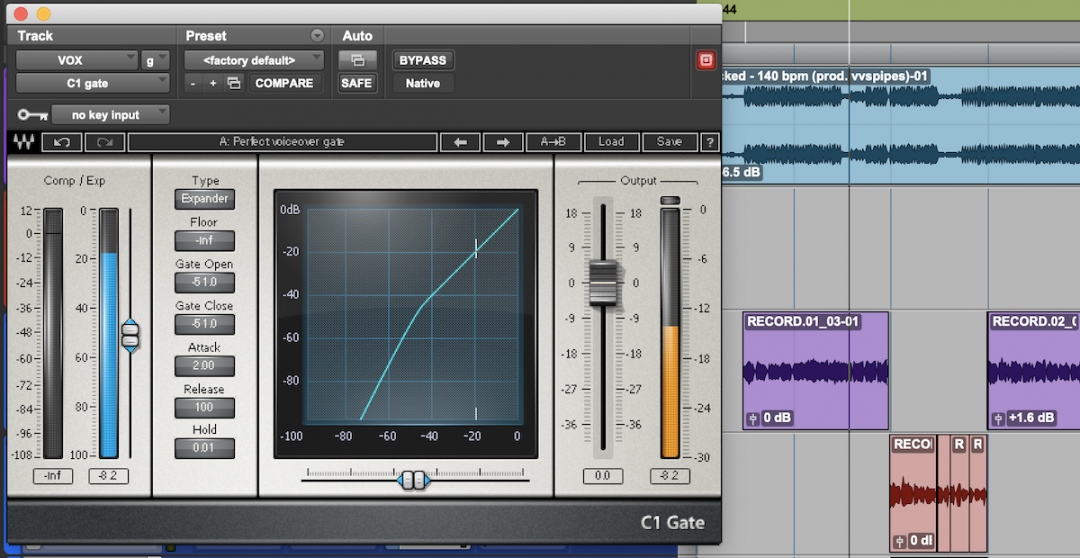A noise gate is a great tool for cleaning up tracks with extraneous noise in between the performances. Also known as a downward expander, noise gates keep a signal turned off or at a lower level until it reaches the threshold. It then opens up and lets the full signal through.
For many years, engineers used gates to reduce or get rid of problems on a track, like extra noise, buzzing, or any other low-level sound picked up by the mic. A great use of a noise gate, for example, is using it to eliminate amplifier hum when a guitarist isn’t playing. Gate pedals are still used by guitar players all the time!
Today, digital editing has somewhat reduced the need for noise gates in mixing. They’re still used, just not as often as in previous years, because now we can finely edit our takes digitally to remove problems. In live sound, gates are still valuable tools for decreasing bleed between all of the mics on stage.
Noise gate parameters are similar to a compressor’s.
- Threshold (dB): Point at which the gate opens.
- Attack (mS): Time it takes for the gate to open fully once the threshold is surpassed.
- Hold (mS or S): A minimum amount of time that the gate must stay open after the threshold is surpassed.
- Release (mS): Time it takes for the gate to close after the signal falls below the threshold. Also called decay.
- Range (dB): Determines the amount of attenuation after the threshold is surpassed and the gate turns on.
Setting a Noise Gate on a Track
For the sake of example we’ll use a snare drum, but the same concepts can be used on any drum, instrument, or vocal.
- Insert the gate on the snare and solo it.
- Raise the threshold until you can hear the snare, but there’s no bleed/extra noise in between hits. Note: If the snare sounds like it’s being throttled or cut off unnaturally, raise the threshold a bit more.
- If it still sounds unnatural, then try increasing the hold or release controls.
- Next, adjust the range parameter for somewhere around 10 dB of attenuation in between snare hits. Whatever sounds most natural is best.
- Fine tune the threshold and release controls until the gate doesn’t “chatter” or make behave oddly. This step requires the most experimentation and patience.
- Now you can time the release so the gate breathes with the rhythm of the song, just like a compressor.
Unfortunately, gates aren’t always as intelligent as we’d like them to be. They’re tricky to set because generally, the dynamics of a signal are constantly fluctuating. It’s a good idea to insert a compressor somewhere in the signal path before the noise gate to improve its performance.
Common Gating Techniques
As we’ve already mentioned, gates are most commonly used to reduce unwanted noise on a track. On drums, they’re frequently used to reduce bleed between the various parts of the kit. You can and may want to gate the most transient parts of the drum kit, like kick, snare, and toms. That way the overheads don’t bleed into every part of the kit and wash out the overall balance.
You can achieve the same effect by manually editing out any sound between hits, of course, but it might sound a bit too choppy. With the right gate settings, you can still allow a tasteful amount of bleed to get through, keeping things natural sounding.
The same concepts can be applied to any instrument, like a buzzy guitar or bass amp or a vocal with extra noise in between phrases.
Creative Noise Gate Techniques
- Make a snare drum sound bigger by gating a reverb return. Next, send the snare signal to the key input on the noise gate. Each time the snare hits, the gate will let some of the reverb/room ambience through, giving it depth and dimension.
- Put a gate on a synth/keyboard pad and key it to the hi-hat to give the pad a rhythmic feel.
- Insert a gate on the bass track and key it to the kick drum. The bass will only play with the kick drum, tightening up the rhythm section. You can adjust the release so the bass sounds less staccato. Or leave it alone if it works!
- Tighten up background vocals by routing them to a bus and gating it. Then send the best-performed background vocal line to the key on the gate. Now, all of the background vocal tracks will enter/exit at the same time.
